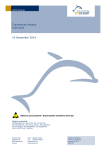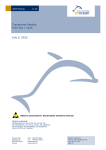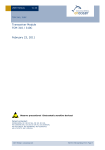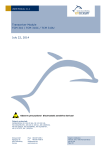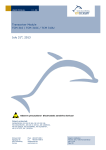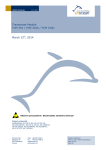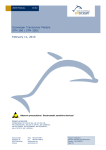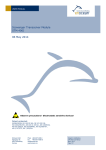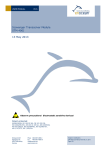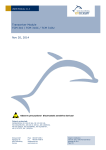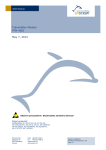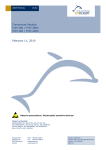Download Transceiver Module TCM 410J 20 August 2013
Transcript
USER MANUAL Transceiver Module TCM 410J 20 August 2013 Observe precautions! Electrostatic sensitive devices! Patent protected: WO98/36395, DE 100 25 561, DE 101 50 128, WO 2004/051591, DE 103 01 678 A1, DE 10309334, WO 04/109236, WO 05/096482, WO 02/095707, US 6,747,573, US 7,019,241 EnOcean GmbH Kolpingring 18a 82041 Oberhaching Germany Phone +49.89.67 34 689-0 Fax +49.89.67 34 689-50 [email protected] www.enocean.com Subject to modifications TCM 410J User Manual August 20, 2013 Page 1/24 USER MANUAL V1.10 TCM 410J REVISION HISTORY The following major modifications and improvements have been made to the first version of this document: No 1.00 1.10 Major Changes Initial version Added certification information and PCB Design Published by EnOcean GmbH, Kolpingring 18a, 82041 Oberhaching, Germany www.enocean.com, [email protected], phone +49 (89) 6734 6890 © EnOcean GmbH All Rights Reserved Important! This information describes the type of component and shall not be considered as assured characteristics. No responsibility is assumed for possible omissions or inaccuracies. Circuitry and specifications are subject to change without notice. For the latest product specifications, refer to the EnOcean website: http://www.enocean.com. As far as patents or other rights of third parties are concerned, liability is only assumed for modules, not for the described applications, processes and circuits. EnOcean does not assume responsibility for use of modules described and limits its liability to the replacement of modules determined to be defective due to workmanship. Devices or systems containing RF components must meet the essential requirements of the local legal authorities. The modules must not be used in any relation with equipment that supports, directly or indirectly, human health or life or with applications that can result in danger for people, animals or real value. Components of the modules are considered and should be disposed of as hazardous waste. Local government regulations are to be observed. Packing: Please use the recycling operators known to you. © 2013 EnOcean | www.enocean.com TCM 410J User Manual V1.10 | Page 2/24 USER MANUAL V1.10 TCM 410J TABLE OF CONTENT 1 MODULE VARIANTS AND RELATED DOCUMENTS ............................................... 4 2 2.1 2.2 2.3 2.4 2.5 GENERAL DESCRIPTION ................................................................................. 4 Basic functionality ......................................................................................... 4 Technical data............................................................................................... 5 Physical dimensions ....................................................................................... 5 Environmental conditions ............................................................................... 6 Ordering information ..................................................................................... 6 3 FUNCTIONAL DESCRIPTION ............................................................................ 6 3.1 Pin out ......................................................................................................... 6 3.2 Pin description and operational characteristics .................................................. 8 3.2.1 GPIO supply voltage - IOVDD ...................................................................... 8 3.3 Absolute maximum ratings (non operating) ...................................................... 9 3.4 Maximum ratings (operating) .......................................................................... 9 3.5 System environment ...................................................................................... 9 3.6 Serial Interface ........................................................................................... 10 3.7 Built-in Repeater ......................................................................................... 11 3.8 Smart Acknowledge ..................................................................................... 11 3.9 Remote Management ................................................................................... 12 3.10 Serial communication with TYPE 01 or TYPE 10 .......................................... 12 3.11 Module configuration ............................................................................... 12 4 APPLICATIONS INFORMATION....................................................................... 13 4.1 Transmission range ..................................................................................... 13 4.2 Antenna options .......................................................................................... 13 4.2.1 Overview ................................................................................................ 13 4.2.2 Whip antenna ......................................................................................... 13 4.2.3 Helical antenna ....................................................................................... 14 4.3 Recommendations for laying a whip antenna .................................................. 17 4.4 Power supply requirements ........................................................................... 18 4.5 Layout recommendations ............................................................................. 18 4.5.1 Recommended foot pattern ....................................................................... 19 4.6 Soldering information .................................................................................. 22 4.7 Tape & Reel specification .............................................................................. 23 5 AGENCY CERTIFICATIONS ............................................................................ 24 A.1 Japanese Type Approval ..................................... Error! Bookmark not defined. © 2013 EnOcean | www.enocean.com TCM 410J User Manual V1.10 | Page 3/24 USER MANUAL V1.10 TCM 410J 1 MODULE VARIANTS AND RELATED DOCUMENTS This document describes operation of TCM 410J module with the frequency 928.35 MHz. Subject of description is the: build in software Gateway Controller. used hardware TCM 410J In the Document we refer to the Hardware and Software characteristic by the module name TCM 410J. In addition we recommend following our application notes, in particular AN101: Power Supply Layout – Layout considerations for Line-Power AN102: Antenna Basics – Basic Antenna Design Considerations for EnOcean based Products The specification of the serial protocol ESP3 can be found here: http://www.enocean.com/esp 2 2.1 GENERAL DESCRIPTION Basic functionality TCM 410J is a SMD mountable radio transmitter module enabling the realization of gateways for EnOcean 928.35 MHz radio systems. It provides a bi-directional radio interface and a bi-directional serial interface. Radio messages are sent transparently through the serial interface in both directions from and to an externally connected host processor or host PC. In addition control commands can be sent from the host, e.g. to configure the repeater functionality or to manage Smart Ack functions. TCM 410J can act as postmaster for up to 15 bi-directional sensors using Smart Ack technology. Features Smart Ack controller functionality Transparent radio channel Programmable repeater functionality (1 Level) ESP3 support (EnOcean Serial Protocol V3) API programmable! © 2013 EnOcean | www.enocean.com TCM 410J User Manual V1.10 | Page 4/24 USER MANUAL V1.10 TCM 410J 2.2 Technical data Features overview Antenna External whip or 50Ω antenna mountable 928.35 MHz (FSK) Frequency Radio Standard Enocean Radio Protocol 2 (FSK) Data rate/Modulation type Receiver Sensitivity (at 25°C) 125 kbps FSK typ. –95 dBm Conducted Output Power Power Supply Serial Interface Current Consumption typ. 0dBm 2.6…5V UART - EnOcean Serial Protocol 3 Receive mode: 27 mA Transmit mode: 22 mA Dimensions of PCB Operating temperature 22x19x3.1 mm -25 to +85°C Radio Regulations ARIB STD-T108 2.3 Physical dimensions Unless otherwise specified dimensions are in mm. Tolerances: PCB outline dimensions 0.2 mm All other tolerances 0.1 mm TCM 410J (pads on bottom side of PCB!) PCB Dimension Weight © 2013 EnOcean | www.enocean.com 22 x 19 x 3.1 mm 1.9 g TCM 410J User Manual V1.10 | Page 5/24 USER MANUAL V1.10 TCM 410J 2.4 Environmental conditions Operating temperature -25 °C … +85 °C Storage temperature -40 °C … +85 °C Storage temperature in tape & reel package -20 °C … +50 °C Humidity 2.5 0% … 93% r.H., non-condensing Ordering information Type TCM 410J 3 3.1 Ordering Code S3063-K410 Frequency 928.35 MHz FUNCTIONAL DESCRIPTION Pin out The figure above shows the pin out of the TCM 410J hardware. The pins are named according to the naming of the Dolphin chip to simplify usage of the DOLPHIN API 2. © 2013 EnOcean | www.enocean.com TCM 410J User Manual V1.10 | Page 6/24 USER MANUAL V1.10 TCM 410J The table in section 0 shows the translation of hardware pins to a naming that fits the functionality of the built-in firmware.. © 2013 EnOcean | www.enocean.com TCM 410J User Manual V1.10 | Page 7/24 USER MANUAL V1.10 TCM 410J 3.2 Pin description and operational characteristics HW Symbol Pin # GND 1, 5, 7, 17, 18, Ground connection 24, 26, 28, 31 2 Supply voltage 8 RF supply voltage regulator output 25 Digital supply voltage regulator output 23 GPIO supply voltage VDD RVDD DVDD IOVDD RESET SER_RX – ADIO6 SER_TX – ADIO7 RF_WHIP RF_50 n.c. 27 15 16 4 6 3, 9-14, 19-22, 29,30, 32-34 Function Reset input UART input UART output RF output RF output Not connected Characteristics Must be connected to GND; see 4.4 2.6 V … 5 V Leave open 1.8 V Output current: max. 5 mA Must be connected to desired interface supply voltage (see 3.4) See also 3.2.1. External 10 kΩ pull-down required. See 3.6 See 3.6 Output for whip antenna 50 Ohm output for external antenna Do not connect! 3.2.1 GPIO supply voltage - IOVDD For digital communication with other circuitry (peripherals) the digital I/O configured pins of the mixed signal sensor interface (ADIO0 to ADIO7) and the pins of the serial interface (SCSEDIO0, SCLKDIO1, WSDADIO2, RSDADIO3) may be operated from supply voltages different from DVDD. Therefore an interface voltage supply pin IOVDD is available which must be connected either to DVDD or to an external supply within the tolerated voltage range of IOVDD. If DVDD=0 V (e.g. in any sleep mode or if VDD<VOFF) and IOVDD is supplied, there may be unpredictable and varying current from IOVDD caused by internal floating nodes. It must be taken care that the current into IOVDD does not exceed 10 mA while DVDD=0 V. If DVDD=0 V and IOVDD is not supplied, do not apply voltage to any above mentioned pin. This may lead to unpredictable malfunction of the device. For I/O pins configured as analogue pins the IOVDD voltage level is not relevant! However it is important to connect IOVDD to a supply voltage as specified in 3.4. © 2013 EnOcean | www.enocean.com TCM 410J User Manual V1.10 | Page 8/24 USER MANUAL V1.10 TCM 410J IOVDD If configured as digital I/O ADIO0 ADIO1 ADIO2 ADIO3 ADIO4 ADIO5 ADIO6 ADIO7 SCSEDIO0 SCLKDIO1 WSDADIO2 RSDADIO3 3.3 Absolute maximum ratings (non operating) Symbol Parameter VDD Supply voltage at VDD IOVDD GND VINA VIND1 VIND2 3.4 Max 5.5 -0.5 0 -0.5 -0.5 3.6 0 2 3.6 V V V V -0.5 2 V GPIO supply voltage Ground connection Voltage at every analog input pin Voltage at RESET, and every digital input pin except WXIDIO/WXODIO Voltage at WXIDIO / WXODIO input pin Units V Maximum ratings (operating) Symbol Parameter VDD Supply voltage at VDD IOVDD GND VINA GPIO supply voltage (see also 3.2.1) Ground connection Voltage at every analog input pin Voltage at RESET, and every digital input pin except WXIDIO / WXODIO Voltage at WXIDIO / WXODIO input pin Max. ripple at VDD VIND1 VIND2 VDDR 3.5 Min -0.5 Min 2.6 Max 5 Units V 1.7 0 0 0 3.6 0 2.0 3.6 V V V V 0 2.0 50 V mVpp System environment In the figure below, TCM 410J is shown in a typical system environment. © 2013 EnOcean | www.enocean.com TCM 410J User Manual V1.10 | Page 9/24 USER MANUAL V1.10 TCM 410J 3.6 Serial Interface TCM 410J provides a bi-directional serial interface which conforms to the EnOcean ESP3 specification. For details regarding ESP3 please refer to the ESP3 specification 1. The data rate on the serial interface is 56.8 kbit/s which is usually interoperable with systems running at 57.6 kbit/s. Direction Nominal serial data rate Tolerance TX (sent by module) RX (received by module) 56888 bit/s (=57600 bit/s - 1.23%) 56888 bit/s < 50 ppm < 5% The following ESP3 commands are supported: Type 1 Radio command for transparent mode (compatible mode) Type 10 Radio command for transparent mode (native mode) Type 2 Responses Type 4 Event o SA_CONFIRM_LEARN to confirm/discard learn in/out o CO_READY to indicate wake up from deep sleep initiated by CO_WR_SLEEP Type 5 Common commands o CO_WR_SLEEP to enter energy saving mode (deep sleep mode) o CO_WR_RESET to reset the device o CO_RD_VERSION to read SW/HW versions, chip ID etc. o CO_WR_BIST to perform flash BIST operation o CO_WR_IDBASE to write ID range base number o CO_RD_IDBASE to read ID range base number 1 http://www.enocean.com/en/enocean_modules/tcm-310/ © 2013 EnOcean | www.enocean.com TCM 410J User Manual V1.10 | Page 10/24 USER MANUAL V1.10 TCM 410J CO_WR_REPEATER to configure repeater functionality CO_RD_REPEATER to read repeater state CO_WR_FILTER_ADD to add filter to filter list (up to 10 filters are supported) CO_WR_FILTER_DEL to delete filter from filter list CO_WR_FILTER_DEL_ALL to delete all filter CO_WR_FILTER_ENABLE to enable/disable supplied filters CO_RD_FILTER to read supplied filters CO_WR_WAIT_MATURITY to wait maturity time before returning radio telegrams CO_WR_MODE - Sets the gateway transceiver mode, either packet type 01 or packet type 10 Type 6 Smart Acknowledge commands o SA_WR_LEARNMODE to set/reset Smart Acknowledge learn mode o SA_RD_LEARNMODE to get learn mode o SA_WR_LEARNCONFIRM to add or delete a mailbox of a client o SA_WR_RESET to send a reset command to a client o SA_RD_LEARNEDCLIENTS to get learned mailboxes/clients o SA_WR_POSTMASTER to activate/deactivate post master functionality Type 7 Remote Management messages up to 256 Bytes o o o o o o o o o All configuration values set via ESP3 commands are held in RAM and will therefore be lost after RESET or after a deep sleep phase. Only Smart Ack mailboxes are stored in FLASH and are available also after RESET or a deep sleep phase. After sending a CO_WR_RESET command, the following CO_READY event indicates wake up reason 06 meaning ”A memory request from the CPU core does not correspond to any valid memory location.” This is caused by the real reset cause used when CO_WR_RESET will be performed. It is not a SW/HW malfunction. 3.7 Built-in Repeater TCM 410J provides the option to activate a one or two-level repeater for EnOcean radio telegrams. 1 Level Repeater, If a received telegram is a valid and original (not yet repeated), the telegram is repeated after a random delay. The repeated telegram is marked as “repeated” by an increased repeater counter. Configuration of the repeater is done via serial interface commands. For detailed recommendations regarding the usage of repeaters please refer to our application note EnOcean Wireless Systems - Installation Notes (PDF), 09/2010. 3.8 Smart Acknowledge TCM 410J provides a post master function with 15 mailboxes for sensors using Smart Ack technology. For more information on smart acknowledge please refer to http://www.enocean.com/en/knowledge-base/. © 2013 EnOcean | www.enocean.com TCM 410J User Manual V1.10 | Page 11/24 USER MANUAL V1.10 TCM 410J When teaching-in a device using Smart Acknowledge please take care to switch off all TCM 4xyJ devices which are not continuously powered. Otherwise these TCM 4xyJ modules could be declared postmaster. As soon as the power supply is switched off, a postmaster would be missing and Smart Acknowledge would not work any longer! 3.9 Remote Management TCM 410J provides a transparent radio channel also for remote management messages with a message length of up to 256 bytes. This enables an external micro controller connected to TCM 410J to handle remote management request from external devices or to control other devices via remote management. For more information on remote management please refer to http://www.enocean.com/en/knowledge-base/. 3.10 Serial communication with TYPE 01 or TYPE 10 TCM 410J operates as transparent gateway so the received radio telegrams are forwarded on as serial packets to external controller with type 01 or type 10. The mode can be switched by the serial command CO_WR_MODE. - Usage of Type 01 is for compatibility reasons (compatibility mode) - Usage of Type 10 is native for the Radio Protocol of TCM 410J. The scenario is depicted on the figure below. For transmission requests from external controller to the TCM 410J both types can be used at any time of the operation. 3.11 Module configuration Configuration parameters will be stored in a non-volatile memory on the TCM 410J module. The parameters will be changeable with the Dolphin Suite configuration. The following parameters will be adjustable: - default mode selection – if serial message are forwarded with serial type 01 or serial type 10 - sniffer mode selection – puts module into sniffer mode, which is suiting for network observation and evaluation - baud rate selection © 2013 EnOcean | www.enocean.com TCM 410J User Manual V1.10 | Page 12/24 USER MANUAL V1.10 TCM 410J 4 APPLICATIONS INFORMATION 4.1 Transmission range The main factors that influence the system transmission range are type and location of the antennas of the receiver and the transmitter, type of terrain and degree of obstruction of the link path, sources of interference affecting the receiver, and “dead” spots caused by signal reflections from nearby conductive objects. Since the expected transmission range strongly depends on this system conditions, range tests should categorically be performed before notification of a particular range that will be attainable by a certain application. The following figures for expected transmission range are considered by using a PTM, a STM or a TCM radio transmitter device and the TCM radio receiver device with preinstalled whip antenna and may be used as a rough guide only: Line-of-sight connections: Typically 30 m range in corridors, up to 100 m in halls Plasterboard walls / dry wood: Typically 30 m range, through max. 5 walls Ferro concrete walls / ceilings: Typically 10 m range, through max. 1 ceiling Fire-safety walls, elevator shafts, staircases and supply areas should be considered as screening. The angle at which the transmitted signal hits the wall is very important. The effective wall thickness – and with it the signal attenuation – varies according to this angle. Signals should be transmitted as directly as possible through the wall. Wall niches should be avoided. Other factors restricting transmission range: Devices mounted on metal surfaces (shielding and detuning of antenna may cause heavy loss of transmission range) Hollow lightweight walls filled with insulating wool on metal foil Suspended ceilings with panels of metal or carbon fibre Lead glass or glass with metal coating, steel furniture The distance between EnOcean receivers and other transmitting devices such as computers, audio and video equipment that also emit high-frequency signals should be at least 0.5 m A summarized application note to determine the transmission range within buildings is available as download from www.enocean.com. 4.2 Antenna options 4.2.1 Overview Several antenna types have been investigated by EnOcean. Please refer to our application notes AN102, and AN105 which give an overview on our recommendations. 4.2.2 Whip antenna 928.35 MHz Antenna: 64 mm wire, connect to RF_WHIP Minimum GND plane: 50 mm x 50 mm Minimum distance space: 10 mm © 2013 EnOcean | www.enocean.com TCM 410J User Manual V1.10 | Page 13/24 USER MANUAL V1.10 TCM 410J Positioning and choice of receiver and transmitter antennas are the most important factors in determining system transmission range. For good receiver performance, great care must be taken about the space immediately around the antenna since this has a strong influence on screening and detuning the antenna. The antenna should be drawn out as far as possible and must never be cut off. Mainly the far end of the wire should be mounted as far away as possible (at least 15 mm) from all metal parts, ground planes, PCB strip lines and fast logic components (e.g. microprocessors). Do not roll up or twist the whip antenna! Radio frequency hash from the motherboard desensitizes the receiver. Therefore: PCB strip lines on the user board should be designed as short as possible A PCB ground plane layer with sufficient ground vias is strongly recommended 4.2.3 Helical antenna 928.35 MHz according to drawing below, connect to RF_WHIP Minimum GND plane: 35 mm x 30 mm Minimum distance space: 10 mm © 2013 EnOcean | www.enocean.com TCM 410J User Manual V1.10 | Page 14/24 USER MANUAL V1.10 TCM 410J 4.2.4 Top loaded PCB spiral antenna R1 R 2 The design of the antenna made on a 1mm thick, two layer FR4 PCB. The dimensions are given in figure below. The hatched areas are double sided in layout. The large area to the left is a ground area. Components can be placed here as long as the area is not split by this nor has long cuts in it which can act as radiators its self. 3 19 18 17 16,55 15,55 14,61 5,46 4,8 4,45 3,45 2,8 2 1 1,95 10,5 13,94 R 2,7 RF feed R 3 1,5 R ,5 R3 2,5 3,7 4,5 6,5 7,3 8 9,54 10,54 11,55 13,05 33,35 15,2 48,55 Dimensions of the PCB antenna. Parameter of PCB VALUE PCB material FR4, 2 layer Thickness (total) 1,27mm Shape Rectangular with millings Dimension 19*48,55 mm Layer Thickness in µm Solder Mask Solder resist Top Layer 35 Core 1200 Bottom Layer 35 Solder Mask Total Exact description Cu, >35um after electroplating Cu, >35um after electroplating Solder resist 1270 The PCB antenna uses three discrete matching components. The position of these components can be seen in figure below. © 2013 EnOcean | www.enocean.com TCM 410J User Manual V1.10 | Page 15/24 USER MANUAL V1.10 C1 TCM 410J L1 L2 Position of matching components The antenna was matched to 50Ω input impedance at the feed point. A compromise for a good matching when plugged into a laptop and when plugged to the end of a USB cable was chosen. Several environments in the proximity of the antenna where also evaluated for this compromise. The following table shows the values of the proposed components. Component Value C1 3.3pF L1 12nH L2 12nH 0603 components where used for the antenna matching. For the capacitor general purpose C0G capacitors with 5% tolerance are sufficient. The inductors should be wire wound inductors from the Würth WE-KI series or the Murata LQW series. © 2013 EnOcean | www.enocean.com TCM 410J User Manual V1.10 | Page 16/24 USER MANUAL V1.10 TCM 410J 4.3 Recommendations for laying a whip antenna PCB with GND PCB without GND Antenna too close to GND area Antenna end led back to foot point Antenna too close to GND area © 2013 EnOcean | www.enocean.com TCM 410J User Manual V1.10 | Page 17/24 USER MANUAL V1.10 TCM 410J 4.4 Power supply requirements In order to provide a good radio performance, great attention must be paid to the power supply and a correct layout and shielding. It is recommended to place a 22 µF ceramic capacitor between VDD and GND close to the module (material: X5R, X7R, min 6.3 V to avoid derating effects). In addition a 470 nH coil shall be inserted (Murata LQW18A, 0603) in the power supply line. For best performance it is recommended to keep the ripple on the power supply rail below 10 mVpp (see 3.4). All GND pins must be connected to GND. Be careful not to create loops! The ground must be realized ideally on both sides of the PCB board with many vias. At least there must be a short star connection. Otherwise RF performance can be reduced! 4.5 Layout recommendations The length of lines connected to I/Os should not exceed 5 cm. It is recommended to have a complete GND layer in the application PCB, at least in the area below the module and directly connected components (e.g. mid-layer of your application PCB). Due to unisolated test points there are live signals accessible on the bottom side of the module. Please follow the following advices to prevent interference with your application circuit: We suggest avoiding any copper structure in the area directly underneath the module (top-layer layout of your application PCB). If this is not possible in your design, please provide coating on top of your PCB to prevent short circuits to the module. All bare metal surfaces including vias have to be covered (e.g. adequate layout of solder resist). It is mandatory that the area marked by the circle in the figure below is kept clear of any conductive structures in the top layer and 0.3 mm below. Otherwise RF performance will be degraded! Furthermore, any distortive signals (e.g. bus signals or power lines) should not be routed underneath the module. If such signals are present in your design, we suggest separating them by using a ground plane between module and these signal lines. © 2013 EnOcean | www.enocean.com TCM 410J User Manual V1.10 | Page 18/24 USER MANUAL V1.10 TCM 410J 4.5.1 Recommended foot pattern Top layer © 2013 EnOcean | www.enocean.com TCM 410J User Manual V1.10 | Page 19/24 USER MANUAL V1.10 TCM 410J Solder resist top layer © 2013 EnOcean | www.enocean.com TCM 410J User Manual V1.10 | Page 20/24 USER MANUAL V1.10 TCM 410J Solder paste top layer The data above are also available as EAGLE library. In order to ensure good solder quality a solder mask thickness of 150 µm is recommended. In case a 120 µm solder mask is used, it is recommended to enlarge the solder print. The pads on the solder print should then be 0.1 mm larger than the pad dimensions of the module as specified in chapter 0. (not relative to the above drawing). Nevertheless an application and production specific test regarding the amount of soldering paste should be performed to find optimum parameters. © 2013 EnOcean | www.enocean.com TCM 410J User Manual V1.10 | Page 21/24 USER MANUAL V1.10 TCM 410J 4.6 Soldering information TCM 410J shall be soldered according to IPC/JEDEC J-STD-020C standard. TCM 410J shall be handled according to Moisture Sensitivity Level MSL4 which means a floor time of 72 h. TCM 410J may be soldered only once, since one time is already consumed at production of the module itself. Once the dry pack bag is opened, the desired quantity of units should be removed and the bag resealed within two hours. If the bag is left open longer than 30 minutes the desiccant should be replaced with dry desiccant. If devices have exceeded the specified floor life time of 72 h, they may be baked according IPC/JEDEC J-STD-033B at max. 90°C for less than 60 h. Devices packaged in moisture-proof packaging should be stored in ambient conditions not exceeding temperatures of 40 °C or humidity levels of 90% r.H. TCM 410J modules shall be soldered within 6 months after delivery! © 2013 EnOcean | www.enocean.com TCM 410J User Manual V1.10 | Page 22/24 USER MANUAL V1.10 TCM 410J 4.7 Tape & Reel specification Tape running direction © 2013 EnOcean | www.enocean.com TCM 410J User Manual V1.10 | Page 23/24 USER MANUAL V1.10 TCM 410J 5 AGENCY CERTIFICATIONS The modules have been tested to fulfil the approval requirements based on the built-in firmware. When developing customer specific firmware based on the API for this module, special care must be taken not to exceed the specified regulatory limits, e.g. the duty cycle limitations! 5.1 Japanese Type Approval TCM 410J complies with the Japanese radio law and is certified according to ARIB STDT108. When the product is placed on the Japanese market, it must carry the Specified Radio Equipment marking as shown below: If the certification label cannot be recognized from outside (e.g. installation in a host) appropriate information must be referenced in the user manual. © 2013 EnOcean | www.enocean.com TCM 410J User Manual V1.10 | Page 24/24
























